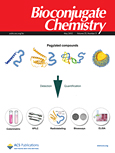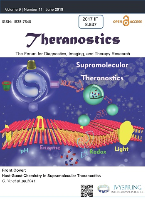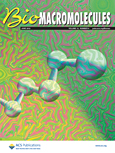
BIOCONJUGATE CHEMISTRY
Scope & Guideline
Connecting Chemistry with Cutting-Edge Biology
Introduction
Aims and Scopes
- Bioconjugation Techniques:
The journal explores various methods of bioconjugation, including chemoselective reactions, click chemistry, and enzyme-mediated coupling, aimed at creating stable and functional bioconjugates. - Therapeutic Applications:
Research published in the journal often highlights the development of bioconjugates for targeted drug delivery, antibody-drug conjugates (ADCs), and vaccine formulations, demonstrating their potential in improving therapeutic efficacy. - Molecular Imaging and Diagnostics:
The journal emphasizes the integration of bioconjugates with imaging agents for enhanced diagnostic capabilities, including PET and fluorescence imaging, showcasing the role of bioconjugates in precision medicine. - Nanotechnology in Bioconjugation:
There is a significant focus on the use of nanocarriers and nanomaterials in bioconjugation, aiming to improve the pharmacokinetics and biodistribution of therapeutic agents. - Research on Biomolecular Interactions:
Studies on the interactions between bioconjugates and biological systems are prevalent, contributing to a deeper understanding of how modifications affect biological activity and stability.
Trending and Emerging
- Targeted Drug Delivery Systems:
There is a significant rise in research focused on targeted drug delivery systems, particularly those utilizing antibody-drug conjugates (ADCs) and other specific targeting mechanisms to enhance therapeutic efficacy. - Nanoparticle-based Bioconjugates:
The use of nanoparticles in bioconjugation is increasingly popular, with studies exploring their roles in drug delivery, imaging, and as carriers for therapeutic agents, indicating a shift towards nanotechnology in bioconjugate applications. - Bioorthogonal Chemistry:
Bioorthogonal reactions are becoming a focal point in the development of bioconjugates, allowing for precise labeling and modification of biomolecules in living systems without interfering with native biochemical processes. - Theranostics:
The integration of therapeutic and diagnostic modalities (theranostics) is trending, with bioconjugates designed for simultaneous therapy and imaging, enhancing personalized medicine approaches. - Synthetic Biology Approaches:
Emerging research reflects the application of synthetic biology in developing novel bioconjugates, leveraging engineered proteins and peptides for therapeutic and diagnostic uses.
Declining or Waning
- Traditional Drug Delivery Systems:
There has been a noticeable reduction in studies focused solely on traditional drug delivery systems without the integration of novel bioconjugation techniques or nanotechnology. - Basic Bioconjugation Methodologies:
Research emphasizing basic bioconjugation techniques without novel applications or advancements is becoming less frequent, as the field increasingly demands innovative approaches and applications. - Non-specific Targeting Strategies:
Studies that do not incorporate targeted delivery mechanisms or specificity in bioconjugate design are seeing a decline, as the field moves towards more precise and effective targeting methodologies. - Classical Imaging Techniques:
There is a waning interest in classical imaging techniques that do not leverage the advancements in bioconjugation, as newer imaging modalities that integrate bioconjugates for enhanced specificity gain traction. - General Reviews without New Insights:
The publication of general reviews that do not provide new insights or advancements in the field is decreasing, as the journal aims to feature more cutting-edge research.
Similar Journals

BIOORGANIC & MEDICINAL CHEMISTRY
Connecting Molecular Insights to Clinical ApplicationsBIOORGANIC & MEDICINAL CHEMISTRY, published by Pergamon-Elsevier Science Ltd, is a prominent journal in the fields of biochemical research and drug discovery, with an ISSN of 0968-0896 and an E-ISSN of 1464-3391. Established in 1993, it has garnered respect and recognition, evidenced by its categorization in various quartile ranks across 2023, including Q2 in Clinical Biochemistry and Pharmaceutical Science. It holds significant Scopus rankings, placing it in the 75th percentile in Pharmaceutical Science and 74th percentile in Organic Chemistry, highlighting its influential contributions to ongoing research and developments. This journal provides a platform for disseminating advancements in bioorganic and medicinal chemistry, focusing on innovative methodologies, therapeutic advancements, and molecular pharmacology. Although it does not follow an open-access model, it remains a key resource for researchers, professionals, and students aiming to stay at the forefront of scientific discovery in the UK and beyond. The journal’s commitment to enhancing knowledge within the biomedical community makes it an essential read for those passionate about this dynamic field.

Theranostics
Innovative Insights for Enhanced Patient Care.Theranostics is a premier journal in the field of Medicine and Pharmacology, published by IVYSPRING INT PUBL. With its commitment to open access since 2011, it facilitates the widespread dissemination of innovative research, fostering collaboration and advancements in therapeutic diagnostics. The journal proudly holds a Q1 ranking in both Medicine (Miscellaneous) and Pharmacology, Toxicology and Pharmaceutics, as of 2023, showcasing its esteemed position within the scientific community. Recognized globally, it ranks in the top 1%, with Scopus rankings placing it as 4th out of 398 in Medicine and 1st out of 43 in Pharmacology. Theranostics serves as a crucial platform for researchers, professionals, and students to explore cutting-edge developments as it converges multidisciplinary approaches to enhance patient care and treatment efficacy. With a focus on bridging experimental research and clinical applications, the journal is instrumental in shaping future therapies and diagnostic strategies.

BIOMACROMOLECULES
Transforming Research into Technological BreakthroughsBIOMACROMOLECULES, published by the American Chemical Society, stands as a premier journal in the fields of bioengineering, biomaterials, materials chemistry, and polymers and plastics. With a commendable impact factor that places it in the Q1 category across these disciplines, it is recognized for its influential research contributions and is ranked strongly within its scopes—16th in Polymers and Plastics and 26th in Biomaterials according to Scopus. Since its inception in 2000 and continuing through 2024, the journal has been pivotal in disseminating significant findings and technological advancements that propel the field forward. Although it does not currently have an open access option, the journal offers invaluable insights that are essential for researchers, professionals, and students engaged in the cutting-edge exploration of macromolecules and their diverse applications. With its address located at 1155 16th St, NW, Washington, DC 20036, BIOMACROMOLECULES is not just a repository of knowledge but also a vital platform for fostering collaboration and innovation within the scientific community.

MOLECULAR CANCER THERAPEUTICS
Pioneering discoveries for a cancer-free tomorrow.MOLECULAR CANCER THERAPEUTICS, published by the American Association for Cancer Research, is a premier journal dedicated to advancing the field of cancer research and therapy since 2001. With a notable impact factor reflecting its high-quality content, this journal stands out in the Q1 category for both Cancer Research and Oncology as of 2023. Researchers, clinicians, and students interested in innovative treatment strategies and molecular mechanisms can find valuable insights within its pages, bolstered by a rigorous peer-review process and a global perspective on cancer therapeutic developments. Although the journal operates under a subscription model, it provides comprehensive access to cutting-edge studies and reviews that drive forward the understanding of cancer biology and treatment modalities. The journal's impressive Scopus rankings further validate its influence within both oncology and the broader cancer research community, making it an indispensable resource for anyone committed to combating cancer through science.

CURRENT OPINION IN CHEMICAL BIOLOGY
Fostering Scholarly Dialogue in BiochemistryCurrent Opinion in Chemical Biology, published by Elsevier Science Ltd, stands at the forefront of its field, specializing in analytical chemistry and biochemistry. With an impressive impact factor and ranked in the top quartile (Q1) for both its disciplines, this journal consolidates significant advancements and perspectives in chemical biology from 1997 to 2024. Its Scopus rankings reflect its prestigious standing, with the journal positioned at #11 in Analytical Chemistry and #32 in Biochemistry, indicating a remarkable percentile standing of 93rd and 92nd, respectively. With a commitment to highlight cutting-edge research and foster scholarly dialogue, Current Opinion in Chemical Biology serves as an invaluable resource for researchers, professionals, and students seeking to stay abreast of the latest developments and innovations in the chemical biology landscape.

BIOPHYSICAL CHEMISTRY
Connecting disciplines to illuminate the science of life.BIOPHYSICAL CHEMISTRY, published by Elsevier, is a prestigious journal with a long-standing tradition since its inception in 1973. This highly respected journal focuses on the intersections of biochemistry, biophysics, and organic chemistry, providing a critical platform for researchers, professionals, and students to disseminate pivotal findings in these dynamic fields. With an impressive impact factor that reflects its robust academic influence and high citation rates, it ranks within the Q2 quartile among its peers in multiple categories, indicating its significance in the scholarly community. The journal, hosted in the Netherlands, encompasses a diverse range of topics, from molecular interactions to protein folding, and serves as an essential resource for those engaged in cutting-edge research. Researchers looking to share their work with a global audience will find BIOPHYSICAL CHEMISTRY an invaluable outlet, fostering the advancement of knowledge in this crucial area of science. For more information, visit the journal's page on the Elsevier platform.

CURRENT MEDICINAL CHEMISTRY
Advancing the Frontiers of Medicinal Chemistry.Current Medicinal Chemistry is a leading journal published by Bentham Science Publishers Ltd, known for its rigorous focus on the multifaceted realm of medicinal chemistry. With an ISSN of 0929-8673 and E-ISSN 1875-533X, the journal plays a crucial role in disseminating high-quality research findings that bridge the gap between chemistry and health sciences. Operating from Sharjah, United Arab Emirates, it has been a prominent scholarly resource since its inception in 1994, and is expected to continue until 2024. Current Medicinal Chemistry has earned its place in the academic community with an impressive impact factor and categorization in Q1 and Q2 quartiles across various disciplines, including Organic Chemistry, Biochemistry, Drug Discovery, and Pharmacology, highlighting its substantial contribution to these fields. Notably, it ranks 24th in Organic Chemistry and is within the 88th percentile, underscoring its appeal to researchers, professionals, and students alike who are keen on exploring cutting-edge advancements in drug design and development. Although it is not an open-access journal, it provides vital content that informs and inspires innovation in medicinal chemistry, appealing to a global audience committed to enhancing human health through scientific discovery.

BIOINORGANIC CHEMISTRY AND APPLICATIONS
Unlocking the potential of inorganic chemistry in biological systems.BIOINORGANIC CHEMISTRY AND APPLICATIONS, published by HINDAWI LTD, is a distinguished journal dedicated to advancing the field of bioinorganic chemistry, offering an open access platform since 2008. With an ISSN of 1565-3633 and E-ISSN of 1687-479X, this journal provides a global forum for researchers, practitioners, and scholars in the vibrant fields of Biochemistry, Inorganic Chemistry, and Organic Chemistry. Recognized for its scholarly impact, it holds an impressive Q2 rank in Biochemistry and Q1 ranks in both Inorganic and Organic Chemistry in the 2023 metrics. Catering to a diverse audience, the journal emphasizes the importance of interdisciplinary research and the application of inorganic chemistry in biological systems. With an accessible range of articles aimed at fostering scientific dialogue and innovation, BIOINORGANIC CHEMISTRY AND APPLICATIONS plays a crucial role in shaping future research and application in the chemical sciences.

MONATSHEFTE FUR CHEMIE
Unveiling Insights from Over a Century of Chemical ResearchMONATSHEFTE FUR CHEMIE, an esteemed journal published by Springer Wien, has been a significant contributor to the field of chemistry since its inception in the late 19th century. With a rich history spanning from 1880 to the present, this journal provides a platform for innovative research and comprehensive reviews in various areas of general chemistry. Although it currently holds a Q3 ranking in the miscellaneous category of chemistry, its commitment to maintaining high academic standards is reflected in its continued relevance and citation impact, as evidenced by its Scopus ranking. Researchers, professionals, and students engaged in chemical sciences will find this journal a valuable resource for advancing their knowledge and contributing to ongoing discussions in the field. For those looking to stay updated on the latest developments in chemistry while engaging with a storied publication, MONATSHEFTE FUR CHEMIE is a pivotal source of insightful content.

RSC Chemical Biology
Advancing Interdisciplinary Discoveries in Life SciencesRSC Chemical Biology is a prestigious journal published by the Royal Society of Chemistry, providing a significant platform for researchers in the fields of biochemistry, genetics, and molecular biology. Launched in 2020, the journal aims to disseminate high-quality research that bridges the gap between chemistry and biology, promoting interdisciplinary studies and innovations that are essential for advancements in life sciences. With an emerging impact factor and ranking in the top quartile (Q1) for multiple categories such as Biochemistry and Molecular Biology, RSC Chemical Biology holds a prominent position in the academic landscape, evidenced by its Scopus rankings placing it in the top 20% and 30% of its respective fields. Although it does not operate under an open-access model, the journal's commitment to accessibility is reflected in its rigorous peer-review process and its role in shaping future scientific discourse. Research published in this journal is vital for contributing to our understanding of complex biological processes and fostering innovations that can lead to real-world applications.